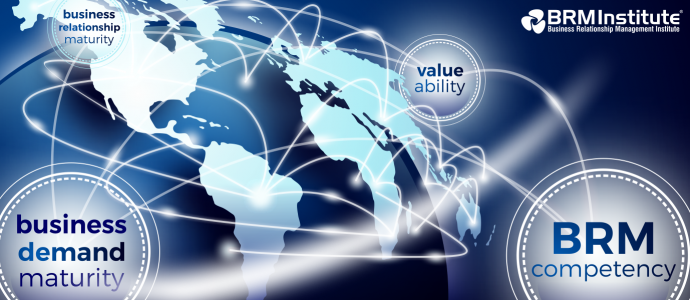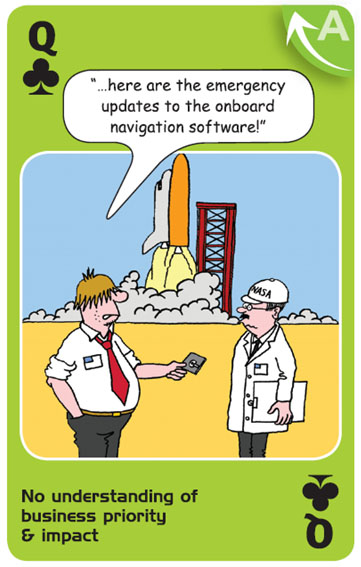Global BRM Trends and Challenges

Over the last couple of years, GamingWorks has traveled around the world to conduct the Grab@Pizza Business & IT simulation game. Alongside our global network of training and consulting partners, we have conducted simulations in Australia, Belgium, Canada, Denmark, Ecuador, Germany, India, the Netherlands, Norway, Oman, Singapore, South Africa, Sweden, Switzerland, the United Kingdom, and the United States.
In particular, many of the simulation games have focused on the BRM role and capability, as well as its relationship with best practices such as ITIL/ITSM and COBIT.
Playing these simulations has brought us into contact with hundreds of organizations, thus allowing us to identify some common issues and trends. This article details some of the key global issues GamingWorks has identified in relation to BRM. Special thanks to Peter Lijnse from Instrumental BRM for his support.
BUSINESS DEMAND MATURITY
- ‘Digital transformation’ is the latest industry buzzword, but few seem to understand what it really means. It’s more than just adopting the latest emerging technologies to streamline operations, improve customer experiences, or gain a competitive advantage—it requires business transformation. Many boardrooms are sadly lacking in digital leadership skills and the majority of IT organizations do not have the strategic BRM role to help address this.
- Too few organizations measure the return on value of their strategic IT investments. A recent CNBC report suggested that 70% of IT investments do not deliver the value they anticipated.
- An ISACA benchmarking study also revealed that “more business involvement in the
Governance of Enterprise IT (GEIT) is required” and highlighted a low maturity score on benefits realization. A symptom of this is how one of the top-scoring ABC (Attitude, Behaviour, and Culture) card in Gamingworks’ global workshops is “everything has the highest priority according to the users.”
- We are still faced with the challenge of convincing the C-level of the value in a BRM capability, despite the fact that without it, organizations may fail to realize their “digital transformation” (however they interpret that phrase) ambitions.
- A recent McKinsey report also revealed “continued misalignment between IT and business executives on IT’s priorities, with little improvement over time,” making a case for the need for a strategic partnership.
BUSINESS FUNCTION MATURITY
- The major barrier to realizing business trust and credibility seems to be the maturity of the ITSM capability. In most organizations, ITSM is operational, meaning it focuses on Incident, Problem, Change, and Service Level Management. Service Portfolio Management is generally a weak area and is not linked to Project Portfolio Management.
- The majority of ITSM/ITIL deployments still seem to be characterized by a siloed approach, lacking an end-to-end organizational alignment and process, or best practice framework integration.
- Many IT function organizations struggle to understand the different types of work (business projects, IT projects, operational changes, and unplanned work) and how they all contribute towards optimizing business value or minimizing value leakage, resulting in a continual reprioritization of IT resources.
- Another key challenge is the internal focus of IT and its metrics. Another top-scoring ABC card in global workshops for 15 years is, “IT has too little understanding of business impact and priority.”
- Although ITSM is lacking the required level of business IQ (such as the impact of outages), BRMs do not seem to realize they should be proactive in helping to provide this and embedding it into ITSM decision-making and priority mechanisms at all levels (strategic, tactical, and operational). This will help demonstrate the added value role that BRMs can deliver to the business function.
- Despite the above-named issues, few IT functions seem to have a formal CSI (Continual Service Improvement) capability, yet this should be a core competence driven and shaped by the BRM. BRM can use CSI to help shift from an internal service focus to be more focused on value optimization with business representation in CSI.
- Too often, BRM is still seen solely as a role—or worse, a process—as opposed to a capability.
- Compounding these issues, there is a growing demand for more agility and flexibility. Existing approaches like ITIL are increasingly seen as a barrier and as their relevance is questioned, there is a growing demand for DevOps. While many BRMs are unfamiliar with DevOps, they could play a role in helping ensure it becomes ‘BusDevOps’—meaning a faster, safer, and better deployment of business value instead of a faster, safer, and better deployment of code features. BRM Institute’s recent white paper “A Perfect Union: BRM and Agile Development and Delivery” explores this idea in more detail.
BRM COMPETENCY
- The majority of organizations say they are doing BRM, but when they experience the simulation and use BRM Institute’s tools and BRMBoK to assess their capabilities, they find themselves reassessing. Many organizations have account manager, business analyst, and information manager roles, but not an organizational BRM capability mandated by the C-level.
- The vast majority of BRMs are either order takers or service providers and struggle to earn the position of strategic partner.
- Additionally, many BRMs are seen as ITSM firefighters, picking up the issues that ITSM doesn’t address because of siloed ITSM capabilities.
- BRMs often do not have a particularly strong knowledge of ITSM practices, which also hinders the relationship with the business function and an ability to suggest appropriate improvements. For example, BRMs can support problem management by identifying areas of value leakage—in other words, making business cases remove this ‘technical debt.’
- Since many BRMs come from operational roles, the process of becoming a strategic partner is a challenge because thinking and acting strategically is new to them.
- Communication is a competency that needs serious attention across the board in IT, confirming findings in a May 2015 com article.
- Very few BRMs see COBIT as a powerful instrument for dialogue and goal alignment between business partner and IT function—the vast majority see it as an audit tool. Meanwhile, the BRM is in an ideal role to leverage this and use it to gain a more strategic foothold.
BUSINESS RELATIONSHIP MATURITY
- There is still a very strong “us” and “them” divide between Business & IT at all levels.
- Participants in the business simulation often say, “We need to do this with our business partner to make them see they are part of the problem.” A strategic partnership requires that both change their behaviour.
- A clear, executive-level ‘role mandate’ is often lacking, making it difficult for BRMs with regard to the IT function and within CSI. ITSM roles ask, “What is the added value of BRM to ITSM?”



If these common issues and observations are a reflection of the true state of affairs, then business transition management is an urgently needed competency. Instead of struggling with Business and IT alignment, the transition that must happen would help both the business partner and the IT function realize Business and IT convergence.
Paul Wilkinson has been working in the IT industry for 30+ years, with a focus on business-IT convergence. He is the owner of GamingWorks, which developed the renowned ‘Grab@Pizza’ business and IT alignment simulation game, commonly used to explore the role of the BRM.
